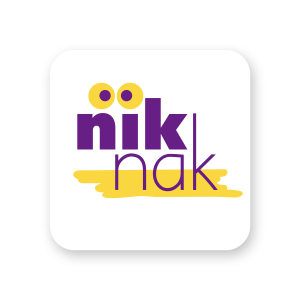Now also kamishibai with nik-nakboekje for multilingual classes

In 2010, Vzw Herkes started with the publication of small (read) books in which besides Dutch another language is available. The intention is to open the door to Dutch for linguistic newcomers, but also to support multilingualism and life in diversity with all families. Today there are seventeen different titles, each available in a number of language combinations. Dutch is combined with English, French, German, Spanish, Italian, Arabic, Turkish, Polish, Russian, Bulgarian, Slovak ... and soon also Portuguese and Chinese (Mandarin).
How are you doing nik-nak booklets now in class? First of all, you can begin by telling a booklet. Some books contain a story, others are about a theme, such as cake types, hair color and style differences, kittens, each of which is different from character. The fun of the books is that they ask the children too: have do you ever knock in your hair? Which cake do you like most? You can easily start interacting with it or use it as a point of departure to work around a theme. In order to facilitate the telling of a group, the first set of narration records (A3 format) appeared in October 2013. There are also tips for activities.
Dutch, of course, remains the central means of communication in the classroom. But differences in home language can also be a place with the books. As a teacher, you bring the story to Dutch, but you can also build a game: for example, who can say 'cake' in another language? And in how many languages can we do that with our class? Or you can invite parents and let them read in smaller groups from the books after you have brought the story in Dutch. You can designate the prints and name them in Dutch. Let children listen to eachother, hear funny words and even discover similarities, it opens their world and they understand what is multilingualism.
The small books in the different language combinations can be brought home. The children will retrieve the story (with some pride) and parents or other family members who are not yet well-attended to in Dutch, can follow the full text by reading the other language, if possible, to read again. Earlier, it has been found that other-language parents are moved to feel this openness and appreciation. In both languages, words with the same meaning are raised, so that the bridge is laid by itself.
Parents with different language background can read nik-nak booklets each in their own language. Any parent who wants to give his child the appreciation for another language can leave his way.
The monolingual Dutch-speaking children also belong to the target audience of nik-nak. The booklets are funny, positive and you get used to it. Diversity is given in the books a self-evident, but not the subject, unless we talk about individual differences. Because everyone is different and everyone can be themselves. Nik-nak in the classroom, they become familiar with the existence of different languages and see them as a standard of death in the world around them. They can also take home a nik-nak booklet, why not choose which combination? It is possible to speak French and English, but you can read it hard to find out that Turkish is full of French words (kuaför, şans (chance) ...)!
More information about nik-nak can be found at www.nik-nak.eu or send an email to info@nik-nak.eu .
Log in or register to view the full educational resource
- free learning resources;
- for all ages and subjects;
- easily searchable on lesson topic.

